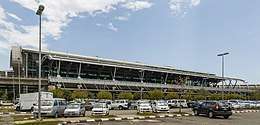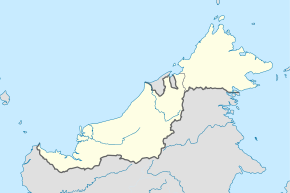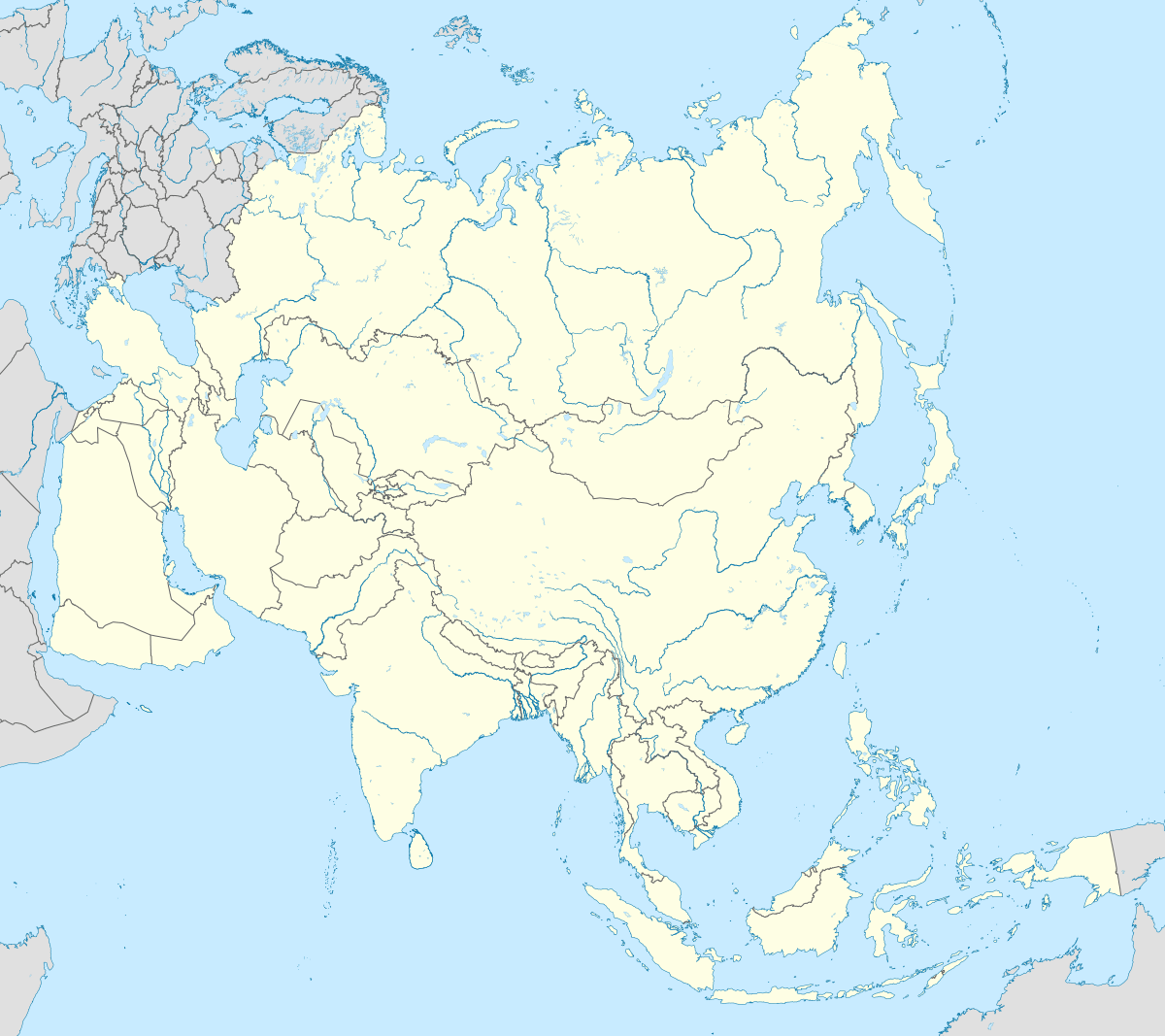Kota Kinabalu International Airport
Kota Kinabalu International Airport (KKIA) (IATA: BKI, ICAO: WBKK) is an international airport in Kota Kinabalu, the state capital of Sabah, Malaysia. It is located approximately 8 km (5.0 mi) southwest of the city centre. In 2017, 8 million passengers passed through the airport, making it the second busiest airport in Malaysia after Kuala Lumpur International Airport. A medium-sized airport with good connections to most major aviation hubs across the Asia-Pacific region, the airport serves the city of Kota Kinabalu as well as the entire west coast of Sabah.
Kota Kinabalu International Airport Lapangan Terbang Antarabangsa Kota Kinabalu | |||||||||||
|---|---|---|---|---|---|---|---|---|---|---|---|
 | |||||||||||
| Summary | |||||||||||
| Airport type | Public | ||||||||||
| Owner | Government of Malaysia | ||||||||||
| Operator | Malaysia Airports Holdings Berhad | ||||||||||
| Serves | Greater Kota Kinabalu (also West Coast and Interior divisions of Sabah) | ||||||||||
| Location | Kepayan and Tanjung Aru, Kota Kinabalu, Sabah, Malaysia | ||||||||||
| Hub for | |||||||||||
| Time zone | MST (UTC+08:00) | ||||||||||
| Elevation AMSL | 10 ft / 3 m | ||||||||||
| Coordinates | 05°56′41″N 116°03′31″E | ||||||||||
| Maps | |||||||||||
 Sabah state in Malaysia | |||||||||||
 BKI /WBKK Location in Sabah State , East Malaysia  BKI /WBKK BKI /WBKK (East Malaysia)  BKI /WBKK BKI /WBKK (Malaysia)  BKI /WBKK BKI /WBKK (Southeast Asia)  BKI /WBKK BKI /WBKK (Asia) | |||||||||||
| Runways | |||||||||||
| |||||||||||
| Statistics (2018) | |||||||||||
| |||||||||||
History
The airport began as a military airfield built by the Imperial Japanese Army during World War II.[3] It was then known as Jesselton Airfield (Kota Kinabalu was known as Jesselton at the time). Towards the end of the war, it suffered severe bombings by Allied Forces.[4]
After the war, the Department of Civil Aviation (DCA) of North Borneo (now Sabah) took over the operation and maintenance of the airport. In 1957, the original grass strip runway was resurfaced with bitumen material and a new terminal was built.[3] By 1959, the runway had been extended to 1,593 metres to enable the operation of Malayan Airways' turboprop Viscount aircraft. In 1963, the runway was further reinforced and lengthened to 1,921 meters to cater for Comet 4 jet operations. Commercial flights and passenger arrivals gradually increased and a larger terminal building was needed. By 1967, Cathay Pacific Airways had begun operating a twice-weekly Convair 880 jet service between the airport and Hong Kong with an intermediate stop in Manila.[5]
In 1969, a British consultancy firm was appointed to formulate a Master Plan for a phased and organised development of KKIA over the next few decades. The master plan was submitted to the government with recommendations to:
- reinforce and extend the runway to 2,987 metres to cater for Boeing 707 and 747 jet operations
- build a new terminal complex and parallel taxiway connecting to the runway
- provide navigation equipment, communication facilities and a modern light system for the runway
In the 1970s and 1980s, a new terminal building was built on the other side of the runway from the original terminal. Almost all commercial flights were shifted to this newer and larger terminal. Subsequently, the original terminal became known as the Airport Lama ("Old Airport"). In 1992, the DCA of Sabah was corporatised and Malaysia Airports Holdings Berhad took over the management and operations of the airport.[3] A further expansion project for both terminals began in 2006, and in January 2007 the original terminal was rebranded Terminal 2 whilst the newer terminal became known as Terminal 1.
As a major economic and leisure hub in Malaysian Borneo, the airport has witnessed the arrival of various Asia-Pacific carriers throughout the years, past operator of the airport includes Air Macau, Airphil Express, Asiana Airlines, Australian Airlines, Cathay Dragon, Cathay Pacific, China Northern Airlines, China Southern Airlines, Dragonair, Far Eastern Air Transport, Fly Asian Xpress, HK Express, Indonesia AirAsia, Korean Air, Lucky Air, Mandarin Airlines, Philippine Airlines, Jetstar Asia Airways, Shenzhen Airlines, Silk Air, Singapore Airlines, South East Asian Airlines, South Phoenix Airways, Thai AirAsia, Thai Airways International, Thai Smile, Tiger Airways, TransAsia Airways, Uni Air, Vladivostok Air, Wings Air and Xiamen Airlines, among few. As of 2020, most of the routes by these previous airlines has been superseded by other airline operators.
Terminal 2 was closed on 1 December 2015 and all airlines shifted their operations to Terminal 1.[6] There are plans to use Terminal 2 for cargo operations and general aviation.[7]
Expansion and renovation
In mid-2005, the Malaysian federal government approved major renovation and refurbishment works to the main terminal (Terminal 1) as well as a runway expansion project worth RM1.4 billion. The project saw the runway extended from 2,988 m (9,803 ft) to 3,780 m (12,402 ft) and the size of the main terminal increased from 34,000 m2 (370,000 sq ft) to 87,000 m2 (940,000 sq ft). Terminal 1 can accommodate four Boeing 747s, one Airbus A330, seven Boeing 737s, three Fokker 50s and three Dorniers at any given time. It has 12 jetways for passenger use.[8][9] The air traffic control tower, which had hitherto been attached to Terminal 1, was demolished and replaced by a stand-alone tower. Due to delays in upgrade works and disputes between the Department of Civil Aviation of Malaysia and the contractor responsible for the project, the runway extension and upgrading of the ILS (Instrument Landing System) was delayed to Q1 2014.[10]
As a result of this expansion, the airport is now able to accommodate the world's largest passenger aircraft, the Airbus A380. It has also become the second largest airport in Malaysia, with an annual capacity of 12 million passengers – 9 million for Terminal 1 and 3 million for Terminal 2.[11]
Generally, flights operating into and out of KKIA are serviced by narrow-body aircraft. However, during school holiday seasons, airlines such as Malaysia Airlines[12] may upgrade their flights to wide-body aircraft, particularly the Airbus A330-300. Additionally, KKIA was the first airport in Malaysia to welcome the Boeing 787 Dreamliner, operated by Royal Brunei during several product introductory flights in November 2013.[13] As to date, the largest aircraft to have utilize the airport are the Boeing 747-8,[14] B777-300ER[15] and Airbus A350 XWB.[16]
Terminals


Terminal 1
Terminal 1 is the newer and the main terminal of KKIA. It can be accessed via Jalan Kepayan, Jalan Lintas and Jalan Putatan located in the suburb or township of Kepayan. The terminal is capable of handling 9 million passengers per annum and is equipped with the following facilities:
- 64 check-in counters for international and domestic flights
- 2 baggage x-ray check-in machines and 5 hand luggage x-ray machines (3 for departures, 1 for VIPs and 1 for staff)
- 36 immigration counters (16 for departures and 20 for arrivals)
- 6 baggage carousels
- 3 floors (Ground floor: arrival hall, first floor: airline offices and local departures, second floor: check-in counters and domestic/foreign departures)
- 9 aerobridges
- 17 aircraft parking bays capable of accommodating wide and narrow body aircraft
- 1,400 car parking bays
The Departure Hall column head design is inspired by the 'Wakid' basket design. A 'Wakid' is, in Sabahan tradition, a symbol of preparing for a meaningful journey. Some ethnic patterns of the Rungus and Bajau ethnic groups are also incorporated into the design of the floor tiles.
The first flight to depart at the new wing was MH2637 to Kuala Lumpur at 06:50 while the last flight at the old wing was at 00:25. Malaysia Airlines is the main operating airline in this terminal.[17]
Terminal 2
Terminal 2 was the original terminal building of the airport when it was first built. It is accessed via Jalan Mat Salleh in Tanjung Aru and is located on the other side of the runway from Terminal 1. Terminal 2 served charter and low-cost carriers, the main airline utilizing the terminal being AirAsia.
In 2006, Terminal 2 underwent a major renovation and extension to accommodate low-cost carriers, reopening on 1 January 2007 in conjunction with Visit Malaysia Year 2007. The works were completed 27 months ahead of schedule. It had 26 check-in counters for domestic and international flights and 6 parking bays for B737 and A320 aircraft as well as 7 luggage x-ray machines, a VIP room and 13 immigration counters. The terminal had the capacity to handle 3 million passengers annually.[11]
However, with limited expansion space and the congestion at Terminal 2, as well as to consolidate all airlines operations in one terminal, airlines at Terminal 2 was ordered to move to Terminal 1. The decision was opposed by AirAsia, and the airline refused to move despite a government directive to do so, missing the deadline five times as of 1 August 2015.[18] The issue was resolved when AirAsia agreed to move to Terminal 1 on 1 December 2015, and Terminal 2 was closed at midnight that day.[6] The terminal will be converted for cargo, charter, VIP flights and general aviation use.[7]
The Terminal currently serves for cargo operators such as Raya Airways and several General Aviation companies such as Weststar and Layang-Layang. Recently, during a state event with many VIP's in attendance, private jets on charter were moved to Terminal 2 to avoid congestion aircraft parking bays on Terminal 1. This includes a Boeing BBJ2 and B747-8i. [19]
Airlines and destinations
Traffic and statistics
Traffic
| Year | Passengers handled |
Passenger % Change |
Cargo (tonnes) |
Cargo % Change |
Aircraft Movements |
Aircraft % Change |
|---|---|---|---|---|---|---|
| 1994 | 2,096,241 | 24,270 | 40,608 | |||
| 1995 | 2,554,181 | 29,537 | 43,882 | |||
| 1996 | 2,622,190 | 23,099 | 45,726 | |||
| 1997 | 2,732,146 | 37,203 | 49,148 | |||
| 1998 | 2,393,431 | 27,942 | 38,716 | |||
| 1999 | 2,752,207 | 27,087 | 40,634 | |||
| 2000 | 3,092,326 | 27,347 | 41,411 | |||
| 2001 | 3,036,196 | 24,887 | 40,157 | |||
| 2002 | 3,256,212 | 28,112 | 44,528 | |||
| 2003 | 3,302,366 | 25,638 | 44,748 | |||
| 2004 | 3,918,201 | 27,191 | 52,352 | |||
| 2005 | 3,975,136 | 25,473 | 51,824 | |||
| 2006 | 4,015,221 | 28,356 | 52,055 | |||
| 2007 | 4,399,939 | 35,638 | 52,047 | |||
| 2008 | 4,689,164 | 34,532 | 54,317 | |||
| 2009 | 4,868,526 | 25,079 | 53,554 | |||
| 2010 | 5,223,454 | 26,733 | 55,241 | |||
| 2011 | 5,808,639 | 28,534 | 59,638 | |||
| 2012 | 5,848,135 | 23,563 | 58,366 | |||
| 2013 | 6,929,692 | 21,922 | 67,601 | |||
| 2014 | 6,792,968 | 23,769 | 73,074 | |||
| 2015 | 6,573,461 | 24,768 | 71,209 | |||
| 2016 | 7,263,339 | 28,764 | 70,138 | |||
| 2017 | 8,006,446 | 27,372 | 73,237 | |||
| 2018 | 8,622,488 | 28,039 | 79,044 | |||
| Source: Malaysia Airports Holdings Berhad[30] | ||||||
Statistics
| Rank | Destination | Frequency (Weekly) |
|---|---|---|
| 1 | 208 | |
| 2 | 71 | |
| 3 | 53 | |
| 4 | 42 | |
| 5 | 39 | |
| 6 | 35 | |
| 7 | 28 | |
| 8 | 21 | |
| 8 | 21 | |
| 8 | 21 | |
| 8 | 21 |
Accidents and incidents
- 6 June 1976 – A chartered Sabah Air aircraft carrying several government ministers crashed in nearby Sembulan upon descending towards the airport, killing 11 passengers including the then-Chief Minister of Sabah Tun Fuad Stephens.[31]
- 4 September 1991 – A chartered Grumman Gulfstream II aircraft crashed into a hill while on approach to the airport, killing all 12 people on board.[32]
Gallery
 Royal Brunei Airlines Boeing 787 Dreamliner taking off
Royal Brunei Airlines Boeing 787 Dreamliner taking off
 Malaysia Airlines Boeing 777-200ER taxiing
Malaysia Airlines Boeing 777-200ER taxiing Korean Air Airbus A300 on the tarmac
Korean Air Airbus A300 on the tarmac Dragonair Airbus A321 after landing
Dragonair Airbus A321 after landing
References
- "Malaysia Airports". Retrieved 18 November 2016.
- WBKK – KOTA KINABALU INTERNATIONAL AIRPORT at Department of Civil Aviation Malaysia
- Profile Archived 27 September 2007 at the Wayback Machine, Department of Civil Aviation, Sabah. Accessed 10 April 2007.
- "USAAF Chronology:". Retrieved 18 November 2016.
- timetableimages.com, Cathay Pacific 16 April 1967 system timetable
- Sario, Ruben (30 November 2015). "KKIA Terminal 2 to close from midnight". The Star (Malaysia). Retrieved 1 December 2015.
- "Airasia must relocate from KKIA'S 'land-locked' terminal 2, says MAHB". The Sun Daily (Malaysia). 17 September 2015. Retrieved 1 December 2015.
- "Airport expansion of national interest: CM" Archived 26 September 2007 at the Wayback Machine, Daily Express News, 12 April 2006.
- Design and Build Contract – Upgrading of the Kota Kinabalu International Airport Project (Package 1 – Terminal Building and Landside Infrastructure & Facilities) Archived 27 September 2007 at the Wayback Machine, WCT Engineering Berhad. Accessed 11 May 2007.
- "KKIA to get ILS in 2014" Archived 6 August 2013 at the Wayback Machine, Malaysian Insider,
- "LCC terminal ready year end" Archived 26 September 2007 at the Wayback Machine, Daily Express News, 23 May 2006.
- "Photo: 9M-MTG (CN: 1318) Malaysia Airlines Airbus A330-323 by ChinJH". Archived from the original on 4 March 2016. Retrieved 18 November 2016.
- "Book International Flights to Asia - Royal Brunei Airlines". Retrieved 18 November 2016.
- "Photo: V8-BKH (CN: 673) B747-8i by Ahmad Sallehuddin A.Sahak". Retrieved 25 January 2017.
- "Photo: HL8250 (CN: 37650) B777-300ER by ChinJH". Retrieved 25 January 2017.
- "MAS Airbus A350 conducts test flight to KKIA". The Borneo Post. 10 January 2018. Retrieved 18 November 2019.
- Kota Kinabalu International Airport, A-Z World Airports Online. Accessed 11 May 2007.
- Yeong, Eva (17 September 2015). "AirAsia to stay put at KKIA Terminal 2". The Sun Daily (Malaysia). Retrieved 13 August 2015.
- "Sultan Johor, Brunei antara tetamu majlis perkahwinan anak KM Sabah". Berita Harian (Malaysia). 17 September 2015. Retrieved 25 January 2017.
- https://www.breakingtravelnews.com/news/article/btn20060105115924331/
- "Air Busan schedules Kota Kinabalu service from May 2019". Routesonline.
- Liu, Jim. "Loong Air adds Xi'An – Kota Kinabalu service from late-Jan 2020". Routesonline. Retrieved 21 January 2020.
- http://www.routesonline.com/news/38/airlineroute/273838/malaysia-airlines-files-tianjin-preliminary-schedule-in-s18/
- "Find a Flight | oneworld". www.oneworld.com.
- "Malindo Air adds Kota Kinabalu – Tianjin from mid-Jan 2019". routesonline.com.
- Template:Ciweb
- "Regional Service (RB Link)". Royal Brunei Airlines. Retrieved 17 July 2019.
- Lim, Sean (22 November 2018). "Frequent fliers on some SilkAir routes will soon have to fly Scoot, SIA announces ahead of merger". businessinsider.sg. Retrieved 30 October 2019.
- "Xiamen Airlines schedules new SE Asia service in W18". Routesonline. Retrieved 11 September 2018.
- "Malaysia Airports: Airports Statistics 2018" (PDF). malaysiaairports. 2 April 2019. Retrieved 14 April 2019.
- Ranter, Harro. "ASN Aircraft accident GAF Nomad N.22B 9M-ATZ Kota Kinabalu Airport (BKI)". aviation-safety.net. Retrieved 1 August 2019.
- Ranter, Harro. "ASN Aircraft accident Grumman American G-1159 Gulfstream II N204C Kota Kinabalu". aviation-safety.net. Retrieved 1 August 2019.
External links
- Kota Kinabalu International Airport at Malaysia Airports Holdings Berhad
- Kota Kinabalu International Airport at Borneo Trade